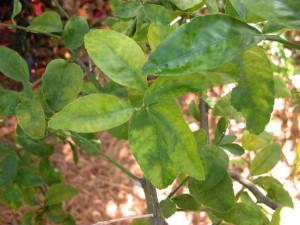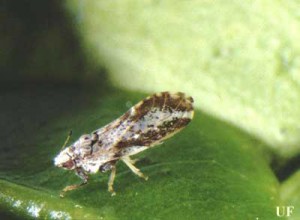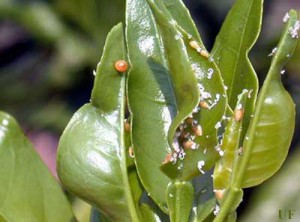Now that planting citrus is allowed again, you need to look out for another disease that is  a bigger threat to our trees than citrus canker. Citrus greening, also known as Huanglongbing (HLB) or yellow dragon disease, is an incurable bacterial infection (Candidatus liberibacter) that was first found in Florida in 2005. It has spread rapidly throughout south Florida including Monroe County. It reduces fruit production, causes a decline in plant health, and can kill your citrus trees.
a bigger threat to our trees than citrus canker. Citrus greening, also known as Huanglongbing (HLB) or yellow dragon disease, is an incurable bacterial infection (Candidatus liberibacter) that was first found in Florida in 2005. It has spread rapidly throughout south Florida including Monroe County. It reduces fruit production, causes a decline in plant health, and can kill your citrus trees.
All species of citrus are susceptible to this disease as are the related ornamentals orange jasmine and orange boxwood.
The first symptom of Citrus Greening is usually blotchy mottling of the leaves. Unlike yellowing caused by nutritional deficiencies, this pattern is asymmetrical. It can be hard to detect during the growing season. Other symptoms are yellow leaves or shoots, dieback, and stunted growth. Fruit may be small, lopsided, green, or bitter.
The infection is spread by an insect, the Asian citrus psyllid (Diaphorina citri) , which feeds on citrus and relate d ornamentals. Once an insect becomes infected, it can transmit the disease to healthy trees for the rest of its life. The adults are small active jumpers with mottled brown wings. They deposit tiny bright yellow eggs on new growth. Nymphs, which are also yellow and have red eyes, are found on new growth too. They excrete a white waxy su
d ornamentals. Once an insect becomes infected, it can transmit the disease to healthy trees for the rest of its life. The adults are small active jumpers with mottled brown wings. They deposit tiny bright yellow eggs on new growth. Nymphs, which are also yellow and have red eyes, are found on new growth too. They excrete a white waxy su bstance and cannot fly.
bstance and cannot fly.
Control of this disease depends upon the removal of infected trees and reduction of the psyllid population. For the homeowner, this means regular inspections of all citrus plants, elimination of ornamental host plants, and encouraging beneficial insects. Pruning infected plants will not help because the infection is systemic, and pesticide effectiveness is limited.
If you suspect your citrus tree may have citrus greening, email the Monroe County Extension Service for advice: kgabel@ufl.edu
Article credits:
Ellen Sculley, UF/IFAS
Photo Credits:
Kim Gabel, UF/IFAS
Doug Caldwell, UF/IFAS
For more information on citrus greening, and to see photographs of the damage it causes and the insects that spread it, see:
http://www.doacs.state.fl.us/pi/chrp/greening/citrusgreening.html
 0
0
